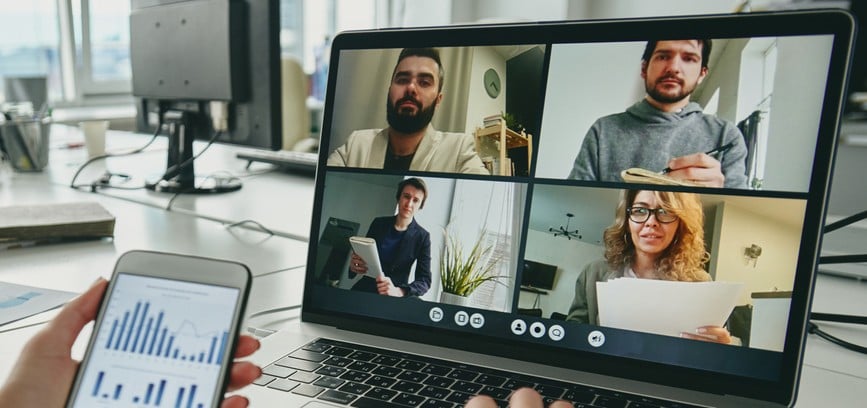How to support digital inclusion in hybrid workplaces
The hybrid workplace model is the new norm in most workplaces, with employees dividing their time between the office and working remotely. Although this provides freedom and flexibility for staff, it is creating a challenge for employers in making sure everyone is productive, engaged, and feels part of an inclusive culture.
So, let’s talk about digital inclusion – what it is, why it’s important, and how you can ensure your future workplace strategy supports it.
What is digital inclusion in the workplace?
Each employee, whether they are working at a physical office or remotely, wants to feel part of the team, and be able to collaborate and work together with colleagues, as if they are just sitting side by side on their workstations or in a conference room.
Digital inclusion focuses on providing the same culture, conditions and opportunities to every staff member, no matter where they are working from. It means leveling the playing field for everyone, and delivering equal access to technology, resources and information required to do their jobs efficiently and effectively.
Digital inclusion therefore becomes critical in a hybrid working environment, where you can have a physically dispersed workforce. It enables employees to feel connected, engaged and empowered to do their best work, wherever they are.
Barriers to digital inclusion
Achieving an inclusive culture is difficult enough when people are all working in the same office, but now there’s that added complexity of working with hybrid teams. Here are some of the challenges that would limit digital inclusion in the workplace:
Technology
Technology can be a great enabler for digital workplaces, but it can also be a barrier to digital inclusion. With people working from different locations, they don’t all have the same internet speeds and wifi capabilities. So, for remote staff, connecting to virtual meetings or conference calls may not be guaranteed or seamless. Also, not having collaboration tools like Microsoft 365 or Google Workspace can create numerous issues that can impact productivity and collaboration between remote and onsite teams.
Culture based on old habits and practices
Digital inclusion won’t work without the cooperation of every staff member. Some people can have the tendency to go back to old habits and practices. They can resist the change to a digital workplace, and prefer to work in a face-to-face environment, leaving out those who are working remotely.
Lack of visibility and connection
Another barrier to digital inclusion is the lack of visibility and connection with remote employees. Business leaders can easily connect with people they physically see in the office and be able to understand their needs and preferences. But it becomes difficult to maintain the same level of service and connection when dealing with remote workers, where there is no physical visibility.
Lack of communication
Equal access to company information is essential in achieving digital inclusion. However, this is not easily achieved. According to Igloo’s 2020 State of the Digital Workplace, nearly 60% of remote workers feel they missed out on important information because it was communicated in person.
Fostering digital inclusion in your workplace
Building an inclusive workplace can work wonders in improving employee engagement and productivity. Here are some ways your workplace can foster digital inclusion:
Conduct a quick audit. To implement any change in the workplace, it’s important to step back and understand the current situation. Observe staff interactions (both onsite and remote) and do interviews and surveys. How do people feel about working in hybrid teams? How much collaboration is happening? Do remote workers feel disconnected?
Create an inclusive culture. Integrate inclusivity in your core company values and then communicate those values effectively to the different teams. It’s also important that the push for digital inclusion starts from the top – so encourage leaders and managers to treat and manage everyone in the same way, no matter if they’re working in the office or remotely.
Implement inclusive communications. This means all company information should be communicated effectively to all employees, both onsite and remote. And make sure you communicate in different ways, including email, chat and other internal communication channels.
Have the right technology. It’s essential to implement technology that can work anywhere. This enables staff to do their best work wherever they are – including equal access to the right collaboration and productivity tools.
Make sure everyone has a voice. Remote workers tend to feel isolated. They sometimes feel unable to participate and be heard. Especially in meetings, encourage everyone to participate and contribute. Ensure each participant has an opportunity to speak out and be respected for their ideas.
How your physical workspace can support digital inclusion
Although the hybrid environment deals with both remote and onsite teams, your physical workplace still plays an important role in supporting digital inclusion.
Create meeting rooms designed for equal participation
Equal participation in a face-to-face meeting is challenging enough – but it becomes even more difficult when you have other people joining through a virtual environment. This requires more than installing a webcam, monitor and speakers in a meeting room. The furniture selection & orientation, in conjunction with appropriate lighting & acoustics, are vitally important to ensure digital inclusion is fostered. There needs to be a meeting moderator and a process in place to ensure that all participants are treated equally and have the same opportunities to speak out and be heard.
According to a senior workplace strategist at Axiom Workplaces, “You need to have great speakers and microphones. I think you need to have a moderator or a facilitator that can control the conversation in a way that the technology can keep up with what’s happening in the room and make it easy for someone who’s joining in remotely, to follow what’s going on.”
Implement seamless room booking technology
Aside from providing equal participation, meetings in a hybrid workplace should be able to allow seamless connectivity and transition between virtual and physical environments.
There is a strong need for an ‘intuitive connection’. People don’t want to spend too much time trying to book a meeting room then struggle to use the technology within the room – which is the usual situation in most organisations. “Breaking down the restraints between the physical space and technology is important. You need to provide dual screens, so that everyone who’s joining in remotely is on screen, despite the fact that you might be sharing information on another screen.”
Deploy a desk booking system
A desk booking system allows employees to book or reserve desk space before they get to the office, through a web browser or mobile app. The system helps you manage the physical office with data and reports for workspace utilisation and planning.
Build collaborative spaces
To build a positive and inclusive culture, it’s important to build collaborative spaces where people can come together when they do come to the office. This will allow workers to build stronger connections with colleagues and make them feel less isolated when working from home.
Axiom recently worked with Cisco Meraki to build a workplace that created a strong sense of culture and community within the organisation. The Axiom team designed workspaces that bring people together, including a coffee bar area and tiered seating purpose-built for the monthly dial-in with San Francisco.
To learn more about building a strong and inclusive culture in a hybrid working environment, check out our interview with Cisco on creating a digitally inclusive workplace.
If you would like to learn how to undertake a Digital Transformation of your workplace click below:








